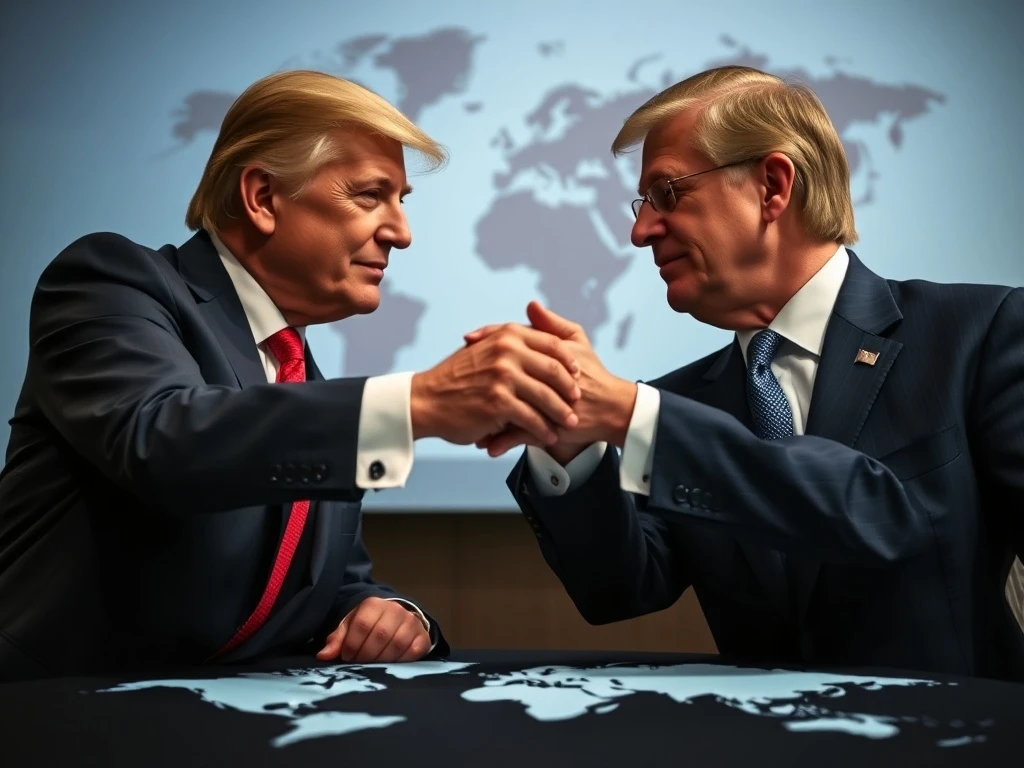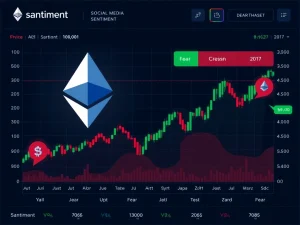U.S.-EU Trade Deal: Crucial Tariffs Set, But Unresolved Disputes Linger

In an increasingly interconnected world, economic shifts in traditional markets inevitably send ripples through the global financial landscape, including the dynamic realm of cryptocurrencies. While the digital asset space often operates on its own unique drivers, major international trade agreements, such as the recent U.S.-EU trade deal, can significantly influence market sentiment, investor confidence, and overall economic stability. Understanding these foundational shifts is crucial for anyone navigating the broader financial ecosystem. Let’s delve into the details of this pivotal agreement and its potential far-reaching effects.
Navigating the New U.S.-EU Trade Deal
On July 27, 2025, the United States and the European Union announced a preliminary trade agreement, signaling a temporary de-escalation of rising transatlantic tensions. This accord, while a significant step, is marked by both progress and persistent ambiguities. The headline feature is a 15% tariff imposed on most EU goods entering the U.S., a notable reduction from the initially threatened 30%. In return, the EU has committed to purchasing U.S. energy and military equipment, aiming to balance the scales.
This deal, announced by President Donald Trump and European Commission President Ursula von der Leyen, successfully averted a full-scale tariff war by capping the rate at 15% for key sectors like cars, industrial products, and various other goods. Furthermore, a ‘zero-for-zero’ arrangement was established, where the U.S. pledged to maintain zero tariffs on aircraft, chemicals, generic drugs, semiconductor equipment, and select agricultural products. This reciprocal agreement aims to protect critical industries from the immediate brunt of tariffs, fostering a sense of stability in these areas.
However, conflicting statements from U.S. and EU officials immediately after the announcement highlighted underlying disagreements regarding sector-specific terms and enforcement mechanisms. For instance, President Trump asserted that the EU would open its markets to U.S. goods at zero tariffs, a claim swiftly refuted by von der Leyen, who maintained that the 15% rate applied broadly. These divergent interpretations underscore the fragility of the agreement and the potential for future friction.
Understanding the Impact of Trade Tariffs
The core of this agreement revolves around trade tariffs – taxes imposed on imported goods. The 15% tariff framework, while a reduction from previous threats, will still have a tangible impact on cross-border commerce. For the EU, particularly export-heavy nations like Germany, this framework could offer a degree of predictability, potentially boosting exports to the U.S. Projections suggest that Germany’s exports could rise from $133 billion in 2023 to $149 billion by 2027 under this new regime. This stability, even with a tariff, is often preferred over the uncertainty of escalating trade disputes.
However, the broader economic implications are complex. While a full-blown tariff war was avoided, the introduction of a 15% tariff on a wide range of goods could still lead to increased prices for consumers and potentially slow economic growth. Businesses may face higher input costs, which could be passed on to consumers, contributing to inflationary pressures. Additionally, while the agreement covers many industrial and consumer goods, it notably excludes agricultural subsidies and digital trade rules, leaving significant structural imbalances unaddressed.
The market reaction has been cautiously optimistic. The EU’s acceptance of the 15% tariff without immediate retaliation has reduced short-term volatility, which is generally positive for all financial markets. However, the lingering uncertainties introduce long-term risks that market participants will closely monitor.
The Thorny Path of Pharmaceutical Trade
One of the most contentious areas left unresolved in the preliminary deal is the future of pharmaceutical trade. Despite the broader 15% tariff agreement, President Trump hinted at the possibility of higher tariffs on pharmaceuticals, beyond the agreed rate. This stance directly contradicts European Commission President von der Leyen’s emphasis on the universality of the 15% tariff.
U.S. officials further clarified that a separate Section 232 investigation into pharmaceutical imports remains active. This investigation, based on national security concerns, could potentially trigger additional, higher tariffs specifically on pharmaceutical products, irrespective of the current trade deal. This ambiguity creates significant uncertainty for pharmaceutical companies operating across the Atlantic, impacting supply chains, pricing strategies, and investment decisions. The health sector is a critical component of both economies, and any disruption here could have far-reaching consequences for public health and economic stability.
Unresolved Steel Tariffs: A Sticking Point
Another major point of contention and a persistent challenge in transatlantic trade relations is the fate of steel tariffs and aluminum tariffs. Currently standing at 50%, these tariffs were initially imposed by the U.S. under national security pretexts. While the broader trade deal aims to reduce tariffs, President Trump asserted that these specific tariffs would ‘stay the way they are.’
In contrast, von der Leyen proposed a quota system and significant reductions for steel and aluminum tariffs, seeking a more amicable resolution. This stark disagreement highlights a fundamental gap in expectations and approaches. The steel and aluminum industries are vital for both economies, and the ongoing uncertainty surrounding these tariffs impacts manufacturers, consumers, and global commodity markets. Resolving this dispute will be crucial for truly normalizing trade relations between the two blocs.
Broader Implications for Global Trade Disputes
The complexities and ambiguities embedded within this U.S.-EU agreement offer a microcosm of the challenges inherent in resolving broader global trade disputes. The deal’s durability hinges significantly on consistent enforcement and shared interpretation. The U.S. maintains leverage through its ability to invoke national security claims for sector-specific tariffs, a tool that can override general trade agreements. Meanwhile, the EU’s willingness to absorb the 15% tariff without immediate retaliation could strain internal consensus among its member states, some of whom may feel disproportionately affected.
Analysts warn that these unresolved political and technical disputes could prolong implementation challenges. Carsten Nickel of Teneo noted that while a full-blown trade war has been avoided for now, the underlying issues have not disappeared. The agreement, while hailed by von der Leyen as a step toward ‘certainty and stability,’ is criticized by others for failing to address deeper, structural trade imbalances that have long plagued transatlantic relations. The ongoing overlapping investigations and differing interpretations suggest that this preliminary agreement is merely a pause, not a definitive end, to the trade tensions.
Looking Ahead: Navigating Future Transatlantic Trade
The preliminary U.S.-EU trade deal represents a critical juncture in transatlantic economic relations. While it successfully averted an immediate escalation of tariff wars and introduced a framework for stability in certain sectors, it also laid bare the deep-seated disagreements over critical industries like pharmaceuticals and steel. The differing interpretations from top officials immediately following the announcement underscore the challenges that lie ahead in fully implementing and solidifying this pact.
For businesses, policymakers, and indeed, all market participants, the agreement serves as a reminder of the dynamic and often unpredictable nature of global trade. The ability to adapt to shifting tariff landscapes, navigate regulatory ambiguities, and prepare for potential disruptions will be paramount. As the world watches how these unresolved disputes evolve, the path to genuine transatlantic trade harmony remains a complex journey, requiring continuous dialogue, compromise, and a shared vision for a stable global economy.
Frequently Asked Questions (FAQs)
Q1: What is the main outcome of the new U.S.-EU trade deal?
The primary outcome is a preliminary agreement that sets a 15% tariff on most EU goods entering the U.S., significantly down from a threatened 30%. It also includes EU commitments to purchase U.S. energy and military equipment, and a ‘zero-for-zero’ arrangement for certain industries.
Q2: Which sectors are still facing unresolved disputes?
Key sectors with unresolved disputes include pharmaceuticals and steel. Despite the general 15% tariff, there are conflicting statements and ongoing investigations that could lead to higher, specific tariffs in these areas.
Q3: How does the 15% tariff impact EU exports to the U.S.?
While a tariff is still a cost, the 15% rate offers more predictability compared to the threat of higher tariffs, potentially boosting EU exports. For instance, Germany’s exports to the U.S. are projected to rise under this framework.
Q4: What is the ‘zero-for-zero’ arrangement mentioned in the deal?
The ‘zero-for-zero’ arrangement means the U.S. will maintain zero tariffs on specific goods like aircraft, chemicals, generic drugs, semiconductor equipment, and select agricultural products, in exchange for the EU foregoing retaliatory measures.
Q5: What are the broader economic implications of this deal?
The deal avoids a full-scale tariff war, reducing short-term volatility. However, the 15% tariff could still lead to higher prices and potentially slow growth. Additionally, it leaves structural imbalances like agricultural subsidies and digital trade rules unaddressed.
Q6: Why are pharmaceutical and steel tariffs so contentious?
These sectors are contentious because of differing interpretations and the potential for the U.S. to impose higher tariffs based on national security claims (Section 232 investigations), which contradicts the broader 15% agreement and creates significant uncertainty for these critical industries.









